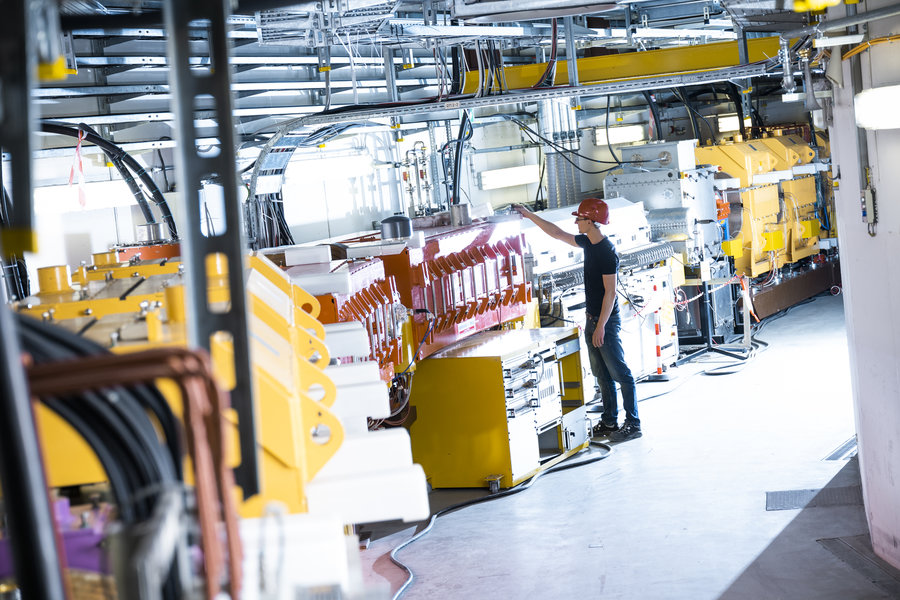Novel space charge compensation – Simulations at GSI/FAIR highlight new technique for the enhancement of ion beam intensities in synchrotrons
06.05.2024 |
A new comprehensive simulation study led by GSI/FAIR scientists demonstrates the potential of pulsed electron lenses to significantly increase the highest achievable intensities of heavy-ion beam ring accelerators. This novel space-charge compensation technique is pioneered at GSI/FAIR, where also a prototype is under development. The study, published in Physical Review Letters, paves the way to overcome the so-called space charge limit in ion synchrotrons.
“Imagine a small number of three-meter-long devices could enable a one-kilometer particle accelerator ring, say the FAIR accelerator SIS100, to deliver 50 per-cent more intense heavy-ion beams. Sounds tempting?” asks Dr. Adrian Oeftiger from GSI/FAIR’s research department Accelerator Physics, who is first author of the publication. Intensity marks the parameter that defines the number of particles that can be accelerated by the synchrotron in order to then collide with a material sample for the experiments. More particles mean more collisions and consequently more scientific data and more results.
To fully exploit the research potential of GSI and FAIR’s facilities, they aim to produce ion beams of worldwide unique intensity. The maximum number of ions per bunch is limited by the electromagnetic fields they generate, known as “space charge”. Space charge counteracts the focusing provided by the magnets which confine the beam within the vacuum inside the beam pipes. At the space charge limit, a maximal ion intensity is reached before beam losses start to occur due to harmful resonances. In order to produce beams of highest intensities for the GSI/FAIR experiments as well as for accelerator facilities elsewhere, accelerator physicists devise strategies to mitigate the impact of space charge.
A new and promising path is followed with the development of pulsed linear electron lenses at GSI/FAIR. These devices generate an intense electron pulse of several hundred kilowatts and guide it such that the electrons overlap with the ion bunches circulating in the accelerator ring. Since electrons are negatively charged in contrast to the positively charged ions, their electromagnetic fields can be arranged so that they compensate for each other aiming to reduce the space charge of the ions. Correspondingly, beam losses from harmful resonances affect the beam only at much higher intensity. Key to success turns out to be providing electron pulses of matching pulse length compared to the passing heavy-ion bunches while, at the same time, avoiding to create additional resonances through the electron beam’s localized space charge field.
“Our now published study demonstrates that only a few such symmetrically arranged devices strongly increase the space charge limit of the accelerator rings. In other words, upgrading the GSI/FAIR accelerators with pulsed linear electron lenses promises to deliver ion beams to the experiments with up to 50 per-cent higher beam intensity compared to the baseline scenario,” explains Oeftiger.
Two key factors made the now published comprehensive simulation study on pulsed electron lenses possible: First, the resonance behavior of the ion beam needs to be simulated accurately in order to determine the space charge limit. This requires detailed measurements and knowledge of the parameters of the accelerator magnets under operational conditions, which is for example – as the only synchrotron worldwide – available for each main magnet in the FAIR accelerator SIS100. Second, such simulations must be both fast and highly accurate, which could be realized by a developed high-performance simulation model using the computing capacities of the GSI/FAIR data center Green IT Cube.
Oeftiger is confident: “All in all, we conclude that pulsed electron lenses offer a new and promising upgrade option for the GSI/FAIR synchrotrons to provide even higher beam intensities to future experiments.” (CP)











